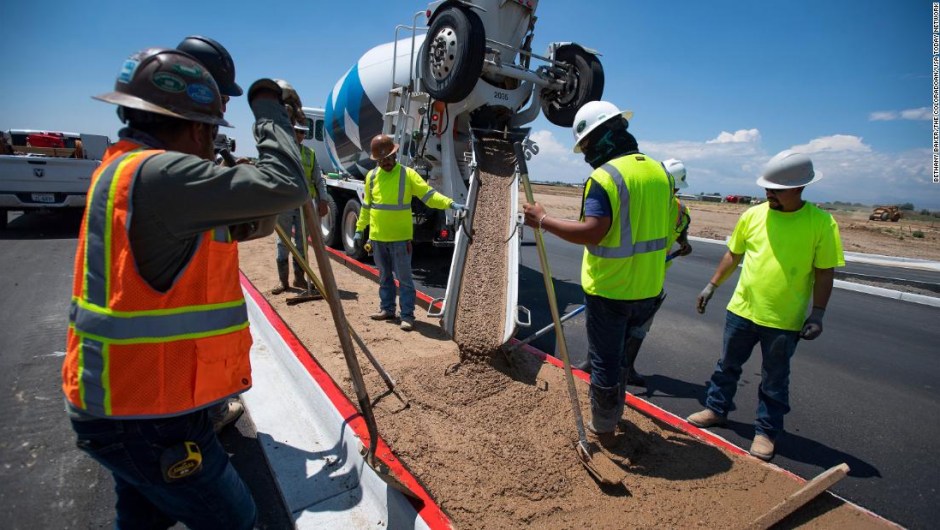New York (CNN Business) -
Matthew Messer carries solar panels on the roof of a house on Long Island, New York, lifting them up one by one in the 37-degree Celsius heat of June.
Messer is the owner of New York Solar Maintenance, but these days he works alongside their lead technician seven days a week as the business prospers.
"This is not the perfect way to spend my time right now," Messer says of his days on the rooftops.
"But it is what must happen."
That's because Messer says he can't find anyone to hire.
Your small business has three job openings, ranging from entry level to lead technician, an example of an industry-wide problem as the scarce workforce does not meet increased demand.
New home construction and improvement is increasing, thanks to a lack of inventory in a red-hot housing market and more people working from home.
In an industry that already had few workers before the pandemic, construction companies will need to hire 430,000 workers this year and 1 million more over the next two years to keep up, according to the organization Associated Builders and Contractors.
"The phone rings busy," Messer said.
"I'm expanding as fast as I can, but right now that is governed by the number of trained technicians I can bring on."
The construction industry shut down for a few months last year during the pandemic, but it was quickly deemed essential, allowing projects on hiatus to continue.
But in that short time, the sector lost more than 1 million workers.
The industry has regained nearly 80% of its workforce since then, but is still with 238,000 workers below pre-pandemic levels as of June, according to the US Department of Labor.
advertising
The US housing market is so attractive that buyers are paying up to $ 1 million above the asking price
"We are losing more people than we are bringing into the industry," said Matthew Schimenti, owner of Schimenti Construction Company.
"People made decisions in their lives to leave the region and the industry [during the pandemic]. It was like putting a puzzle back together to restart where we literally asked for a pause."
Schimenti Construction, which works primarily on commercial projects, has 20 job openings at all levels.
They have even hired two internal recruiters just to scout for talent.
Commercial construction was largely unchanged during the pandemic, but is expected to recover as the US economy returns to pre-pandemic norms.
"If we wanted it to be just a nightmare and go away and everyone would come back, that's not going to happen," Schimenti said.
The problem is not the payment
When Matthew Messer began noticing a worker shortage, he realized that he quickly had to increase wages to remain competitive.
His remaining employees were being poached by other companies.
In the last four months, he has increased basic wages by 40%.
That is in addition to rising costs for materials, including steel and wood, which he says are borne by the customer.
"I was offering between $ 18 and $ 22 an hour and I didn't get requests. I raised it to $ 23 and didn't get any. I raised it to $ 25 and they are starting to come in now," Messer said.
"It was a spectacular increase, but to grow the business, I need technicians."
But unlike other industries facing labor shortages, such as restaurants and hotels, construction pays nearly double the average hourly rate.
A restaurant or hotel worker can earn $ 18.23 an hour, on average, compared to $ 32.86 an hour for a construction worker, according to the Bureau of Labor Statistics.
"You can make a very good living while learning. If you want to learn various crafts, we will teach you several," said Michael Bellman, president and CEO of Associated Builders and Contractors.
"Our members invested $ 1.3 billion last year to improve the skills of their current workforce."
Lack of carpentry classes and an aging population
Woodworking classes - once integrated into the curriculum in schools across the country - are now few and far between.
Often times, those classes had been a student's first introduction to a power tool or tape measure, and a major boost to construction work.
The lack of woodworking classes has made it difficult for the industry to attract and recruit young talent, according to Bellman.
That, plus an aging construction workforce (median age 43) has created a job gap.
"We want to go to all the areas where we can attract the best talent. Once we bring them into the industry, we are educating and improving their skills," said Bellman.
These recyclable bricks seek to revolutionize the construction industry
Teaching new skills at no additional cost to workers is geared towards retention.
In the last decade, the average monthly turnover rate in construction has been 5.2%, compared to 3.6% for all industries, according to the Bureau of Labor Statistics.
And until the number of employees meets the demand, companies will increasingly look to technology to fill vacancies.
"The industry is using technology and innovation to basically handle this disruption regarding labor shortages. A lot of use of drones, robotics and additive manufacturing," Bellman said.
"However, that creates new professional opportunities in those spaces of innovation and technology. And that is very attractive for the younger generation."
Kate Trafecante contributed to this report.
Building






/cloudfront-eu-central-1.images.arcpublishing.com/prisa/GDO6WKTQ7RFXX2LM5LUOSIODT4.jpg)






/cloudfront-eu-central-1.images.arcpublishing.com/prisa/KMEYMJKESBAZBE4MRBAM4TGHIQ.jpg)

